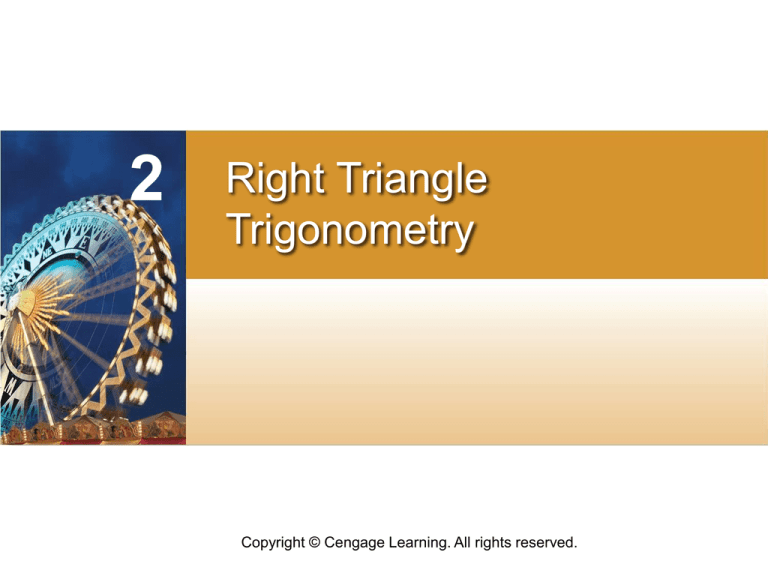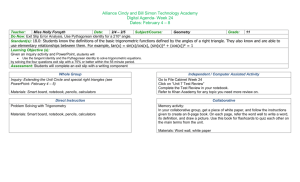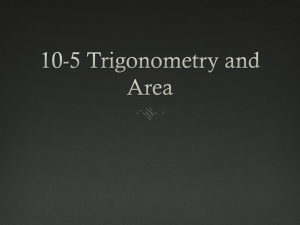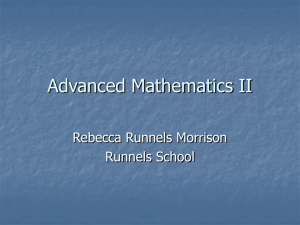
CHAPTER
2
Right Triangle
Trigonometry
Copyright © Cengage Learning. All rights reserved.
SECTION 2.1
Definition II: Right Triangle
Trigonometry
Copyright © Cengage Learning. All rights reserved.
Learning Objectives
1
Find the value of a trigonometric function for an
angle in a right triangle.
2
Use the Cofunction Theorem to find the value of
a trigonometric function.
3
Find the exact value of a trigonometric function
for a special angle.
4
Use exact values to simplify an expression
involving trigonometric functions.
3
Definition II: Right Triangle Trigonometry
4
Example 1
Triangle ABC is a right triangle with C = 90°. If a = 6 and
c = 10, find the six trigonometric functions of A.
Solution:
We begin by making a diagram of ABC (Figure 2) and then
use the given information and the Pythagorean Theorem to
solve for b.
Figure 2
5
Example 1 – Solution
cont’d
Now we write the six trigonometric functions of A using
a = 6, b = 8, and c = 10.
6
Example 1 – Solution
cont’d
7
Definition II: Right Triangle Trigonometry
Now let’s see what happens when we apply Definition II to
B in right triangle ABC.
8
Definition II: Right Triangle Trigonometry
9
Definition II: Right Triangle Trigonometry
As you can see in Figure 4, every trigonometric function of
A is equal to the cofunction of B.
Figure 4
10
Definition II: Right Triangle Trigonometry
That is, sin A = cos B, sec A = csc B, and tan A = cot B, to
name a few.
Because A and B are the acute angles in a right triangle,
they are always complementary angles; that is, their sum is
always 90°.
What we actually have here is another property of
trigonometric functions:
The sine of an angle is the cosine of its complement, the
secant of an angle is the cosecant of its complement, and
the tangent of an angle is the cotangent of its complement.
11
Definition II: Right Triangle Trigonometry
Or, in symbols,
and so on.
We generalize this discussion with the following theorem.
12
Definition II: Right Triangle Trigonometry
To clarify this further, if two angles are complementary,
such as 40° and 50°, then a trigonometric function of one is
equal to the cofunction of the other.
That is, sin 40° = cos 50°, sec 40° = csc 50°, and
tan 40° = cot 50°.
13
Example 3
Fill in the blanks so that each expression becomes a true
statement.
a.
b.
c.
Solution:
Using the theorem on cofunctions of complementary
angles, we fill in the blanks as follows:
a.
14
Example 3 – Solution
cont’d
b.
c.
15
Definition II: Right Triangle Trigonometry
For our next application of Definition II, let us consider the
two special triangles 30°–60°–90° triangle and the
45°–45°–90° triangle. Figure 5 shows both of these
triangles for the case in which the shortest side is 1 (t = 1).
Figure 5
16
Definition II: Right Triangle Trigonometry
Using these two special triangles and Definition II, we can
find the trigonometric functions of 30°, 45°, and 60°.
If we were to continue finding the sine, cosine, and tangent
for these special angles (Figure 6), we would obtain the
results summarized in Table 1.
Figure 6
17
Definition II: Right Triangle Trigonometry
Because we will be using these values so frequently, you
should either memorize the special triangles in Figure 5 or
the information in Table 1.
Exact Values
Table 1
Table 1 is called a table of exact values to distinguish it
from a table of approximate values.
18
Example 5
Let x = 30° and y = 45° in each of the expressions that
follow, and then simplify each expression as much as
possible.
a. 2 sin x
b. sin 2y
c. 4 sin (3x – 90°)
Solution:
a.
b.
c.
19
Definition II: Right Triangle Trigonometry
To conclude this section, we take the information
previously obtained for 0° and 90°, along with the exact
values in Table 1, and summarize them in Table 2.
Table 2
20
Definition II: Right Triangle Trigonometry
To make the information in Table 2 a little easier to
memorize, we have written some of the exact values
differently than we usually do. For example, in Table 2 we
have written 2 as
, 0 as
, and 1 as
.
21





